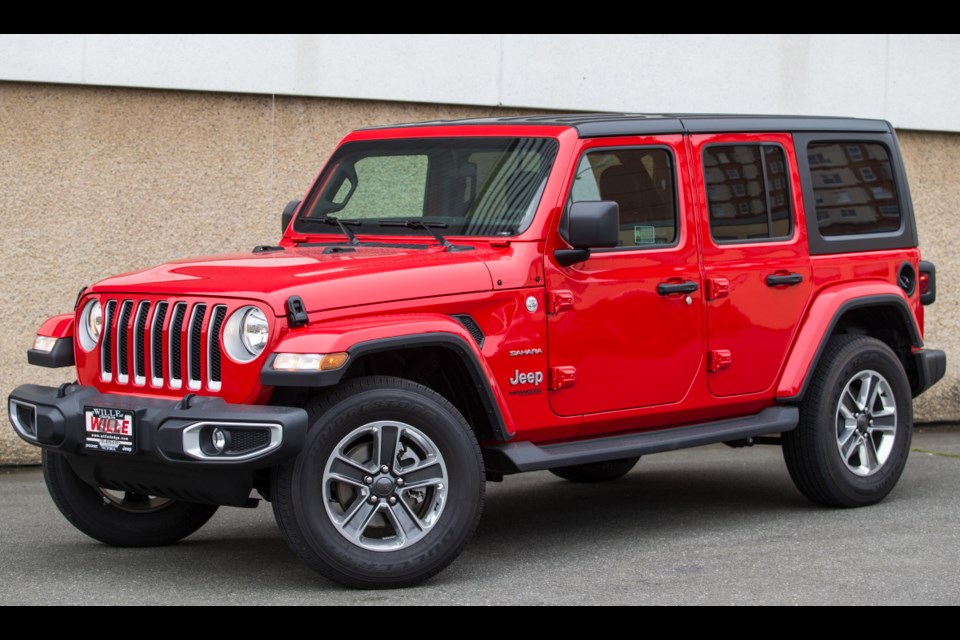There is something both endearing and enduring about the 2018 Jeep Wrangler.
With only subtle changes to the shape of the body, I wager most motorists won’t give the new Jeep a second glance.
But for the legions of Jeep fans, the 2018 model represents the road ahead for the much-loved vehicle. It is available as either a two-door or four-door model. Jeep calls the four-door variant Unlimited, and I drove an Unlimited Sahara model, with a base price of $45,745.
In Jeep-speak, this is the JL, the fourth-generation Wrangler, which started life as the YJ in 1986. For the Unlimited, however, this is only the second generation, as Jeep never offered a four-door variant before 2007. (The Jeep’s history includes the 1954-1983 CJ-5.)
While the two door variant is still the go-to vehicle by diehard off-road enthusiasts, the four-door actually outsells it.
The reason is simple — the majority of people use their Jeeps to scramble from tight parking spots, not narrow mountain ledges.
Jeep owes some of the Wrangler Unlimited’s growth to the explosive popularity of SUVs. That class has dominated the automotive landscape for the past decade, and Jeep has flourished better than most.
Consumers, faced with many more SUV choices than before, seem to gravitate to the Jeep because it stands out from the crowd — as I noted earlier, the Jeep’s iconic silhouette hasn’t changed at all.
The brand also imparts a rugged, no-nonsense attitude that appeals to a go-anywhere, any-time type of buyer. It doesn’t hurt that the standard four-wheel drive can go up slopes like a mountain goat in a snowstorm while the competition has to stay home in their heated garages.
Look a little closer and you can spot the differences on the front grille and the new integrated fog lights. The TL body length is 88 millimetres longer than before, with a corresponding 62-mm stretch to the wheelbase.
Although the body width remains essentially the same, the front and rear tracks have increased by 26 mm.
The Wrangler can be ordered with either a standard 3.6-litre V-6 or an optional turbocharged 2.0-litre four cylinder.
A six-speed manual transmission comes standard with the V-6. An eight-speed automatic is an option for the V-6 and comes bundled with the turbo four (which adds $2,590 to the price of the Jeep).
The V-6 produces 285 horsepower and 260 foot-pounds of torque, plenty of low-end oomph for off-roading and plenty of power for merging on the highway and towing. The turbo four is slightly lower in horsepower, at 270, but offers 295 lb.-ft. of torque for those who love crawling over obstacles.
The new eight-speed automatic is exceptionally smooth, with gear shifts almost imperceptible.
While the Wrangler Unlimited goes bumper-to-bumper with dozens of SUVs on the road, it does offer a unique experience for those who have a taste for wind in the hair and bugs in the teeth.
The Unlimited Sahara comes standard with what Jeep calls its Freedom Top — essentially a hardtop bolted onto the body. You can order the vehicle with a soft top and convert the Unlimited into a four-door convertible. If that’s too much for you, you can now order their new Sky power soft top. This $3,995 option is basically a fold-back fabric panoramic sun roof.
You can order the Jeep with half-doors (fabric on the upper half) or even pop off the aluminum doors, for that truly naked feeling when driving. Even with the doors removed, occupants are protected in the event of a side collision by seat-mounted side airbags.
Fold the windshield down (Jeep says it involves four bolts and about five minutes’ work) for a unique, in-your-face feeling.
Even with all the body parts removed and the windshield folded, an integrated rollover cage remains to protect you and your passengers should you ever try to play turtle with your Jeep.
Given our weather on the coast, there may be few days of the year you can strip your Jeep down, but I bet those few days would be memorable.
Living with the JL the rest of the year just became a lot easier with the 2018 models, as Jeep has refined the interior to provide greater creature comforts for occupants.
Jeep’s latest Uconnect infotainment system deserves kudos for its ease of operation and crisp resolution. The cabin feels more upscale, with better (and more soft-touch) materials on the dash.
One notable change — the push button door handles have been replaced with pull handles.
I haven’t dwelled on off-road performance because I never took it there. But Jeep tells me that it is much the same as before.
The Sahara comes standard with a 3.45 overall top rear-axle ratio (the Rubicon has a 4.10 rear) with Dana M186 front and M200 rear axles.
You can order the Wrangler with all-terrain tires (it comes standard with on/off-road rubber), an anti-spin rear differential or a 2.72:1 selec-trac full-time 4x4 system. The V-6 model weighs 2,494 kilograms and has a 1,588-kg (3,500 lb.) towing capacity.
Jeep has, with the new JL, managed to keep their band of diehard purists happy while offering the rest of us a good reason to try one on for size — on or off the road.
THE SPEC SHEET
Type: Four-door SUV, Front-engine, 4x4
Engine: 3.6-litre V-6, 285 hp at 6,400 r.p.m., 260 lb.-ft. of torque at 4,800 r.p.m.
Transmission: Eight-speed automatic
Dimensions (mm): Length, 4,785; width, 1,875; height, 1,868 ; wheelbase, 3,008
Curb weight (kg): 1,965
Price (base/as tested): $45,745/ $51,425 (includes $1,795 freight and PDI and $100 AC tax)
Options: Leather seating $995, cold winter group $895, automatic transmission $1,595, proximity key $300
Tires: 255/70 R 18 on/off road tires on alloy wheels
Fuel type: Regular
Fuel economy (L/100km): 10.2 highway/ 12.9 city
Warranty: Three years/60,000 km new car, five years/100,000 km powertrain and roadside assistance



